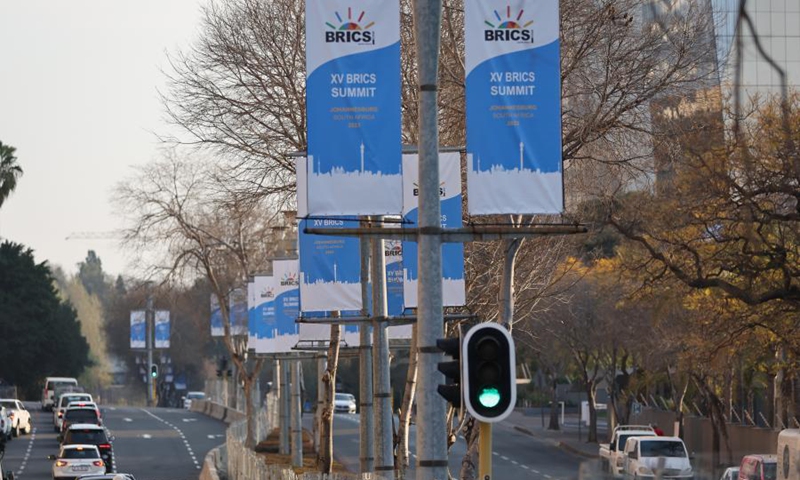Irreversible trend for more economies to shift away from US dollar: experts
The member states of the BRICS, the emerging market group of Brazil, Russia, India, China and South Africa, are widely anticipated to deepen financial cooperation in an upcoming gathering, in particular in the payment and currency sectors to counterbalance the hegemony of the US dollar, which has left emerging economies and developing countries struggling financially.
Based on the trade scale of the BRICS members and the increasing willingness of more countries to join the bloc, the process of de-dollarization, which has become an irreversible trend, will be accelerated, experts told the Global Times.
Data from China’s General Administration of Customs showed that China’s trade with other BRICS economies kept expanding in the first seven months of this year, a potent driving force for the recovery of the overall global economy.
China’s trade with other BRICS members totaled 2.38 trillion yuan ($325.7 billion) over the period, up 19.1 percent year-on-year. This segment of trade accounted for 10.1 percent of China’s overall foreign trade during the period, up 1.6 percentage points from last year.
Chinese shipments to BRICS members reached 1.23 trillion yuan, up 23.9 percent year-on-year, while imports rose 14.3 percent to 1.15 trillion yuan.
Since its establishment, the multilateral cooperation mechanism of BRICS has provided development tools based on partnership and joint growth, in comparison with the Western model that pursues its own interests.
In the upcoming BRICS 2023 summit scheduled from August 22 to 24 in South Africa, discussion of financial cooperation including the use of more local currencies for trade settlements, exploration of a parallel payment system to counter the dollar’s hegemony and a common currency is highly anticipated.
The nations will discuss deepening the use of local currencies in trade, which is “firmly on the agenda,” and a technical committee is likely to be formed to start considering a potential joint currency, South Africa’s BRICS Sherpa Anil Sooklal said in an interview with Bloomberg last week.
“The rising use of local currencies has become a widespread alternative to the dollar. It’s a long-term trend, although its influence is still limited at present,” Niu Haibin, director of the Institute for Foreign Policy Studies from the Shanghai Institutes for International Studies, told the Global Times.
The New Development Bank, created by the BRICS in 2015, has set a target to increase local currency lending from about 22 percent to 30 percent by 2026.
China and Russia have taken a leading role in promoting local currency settlement. More than 80 percent of trade settlements between Russia and China have been conducted in Russian rubles and the yuan, Russian President Vladimir Putin said at the opening of the Shanghai Cooperation Organization (SCO) summit on July 4, according to a report by Russian news agency TASS.
In terms of the payment system within BRICS, Wang Youming, director of the Institute of Developing Countries at the China Institute of International Studies in Beijing, told the Global Times on Monday that “it is not very difficult at the operational level, given sufficient study of multiple banks.”
There has been an ongoing discussion within the BRICS to accelerate the rollout of a payment system, and the need became particularly urgent after the US removed some Russian banks from the SWIFT global interbank payments system and forced other economies to pay for its economic problems with sizeable financial tightening.
Furthermore, Wang said that the BRICS members could move to establish a version of their own monetary fund on the basis of the existing BRICS emergency reserve arrangement mechanism. “The rollout of the fund, in answer to the International Monetary Fund (IMF) that is mainly led by the West, is also not that difficult at the operational level,” he noted.
However, in terms of a potential joint currency within the BRICS, the expert said it is not likely to materialize in the short term.
Undeniably, the BRICS countries differ substantially in terms of economic composition, monetary policy, trade, growth and financial openness. “The lack of a unified market among the BRICS members is a major stumbling block for the exploration of the joint currency,” Wang said.
Although it’s not possible to shake the dominant status of the dollar in global trade and settlement at the current phase, experts stressed that the greenback’s hegemony could not be sustained, with more countries seeking to reduce reliance on the currency.
Concerns in the US are mounting with such global energy powers as Saudi Arabia, Iran, the United Arab Emirates and Venezuela having expressed interest or applied to join the BRICS bloc.
“If they are in, the chance of de-dollarization in global oil trading will be much higher,” Wang said.
According to the government of South Africa, more than 40 countries have expressed interest in joining the bloc.
The BRICS members represent nearly 42 percent of the global population and account for about 26 percent of the global economy, according to media reports.
(Global Times)




